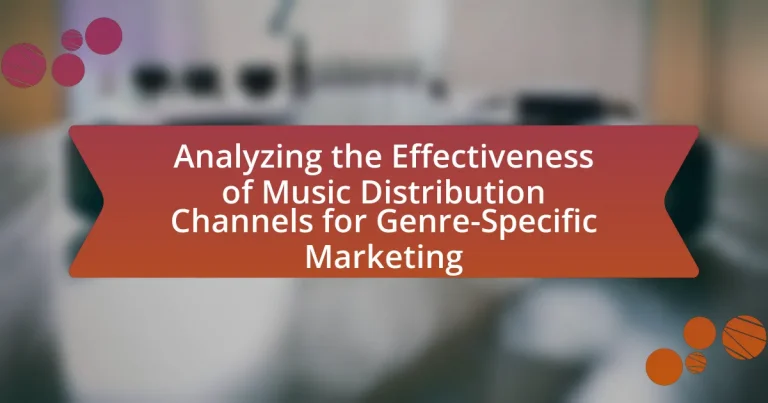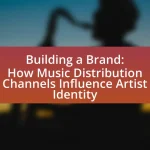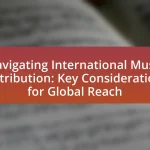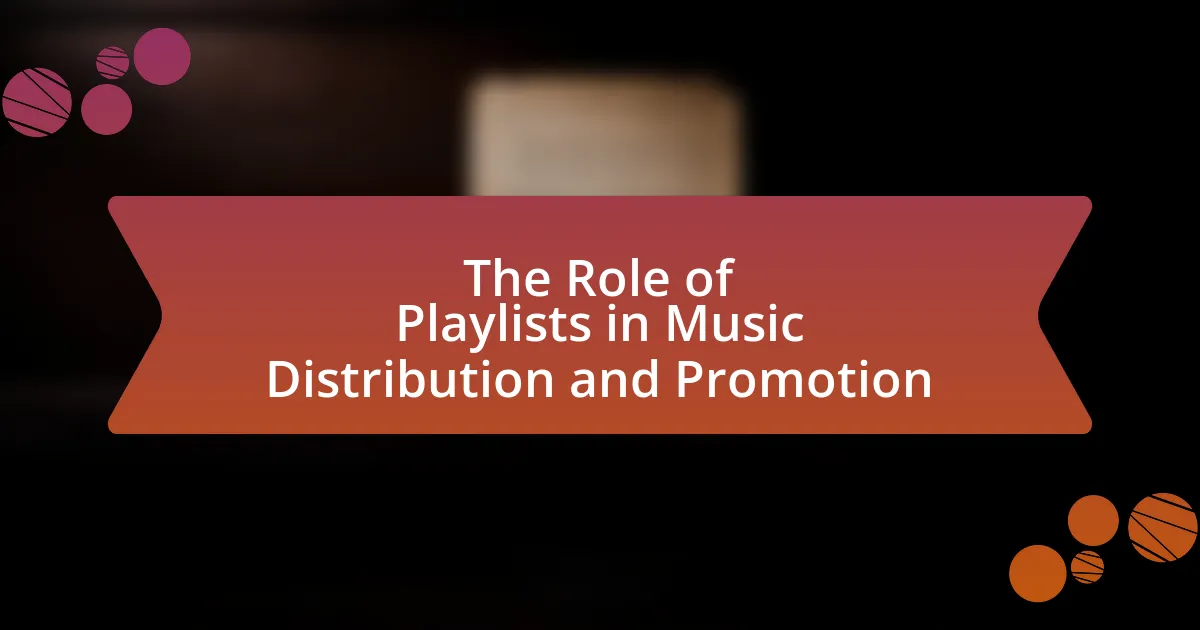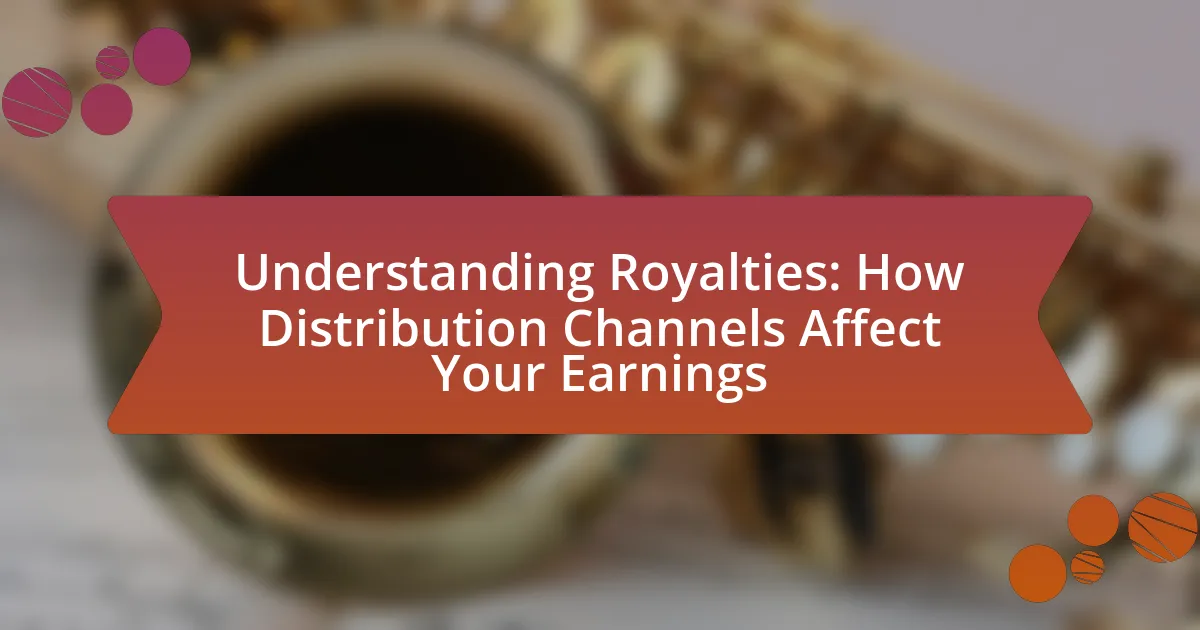Music distribution channels are essential platforms and services that enable artists to deliver their music to consumers, encompassing digital streaming services, physical distribution, and online retailers. This article analyzes the effectiveness of these channels in relation to genre-specific marketing, highlighting how different platforms cater to distinct musical styles and audiences. It discusses the various types of distribution channels, their impact on artist visibility and revenue generation, and the importance of tailored marketing strategies that align with genre characteristics. Additionally, the article explores best practices for artists to optimize their use of these channels to enhance audience engagement and drive sales.
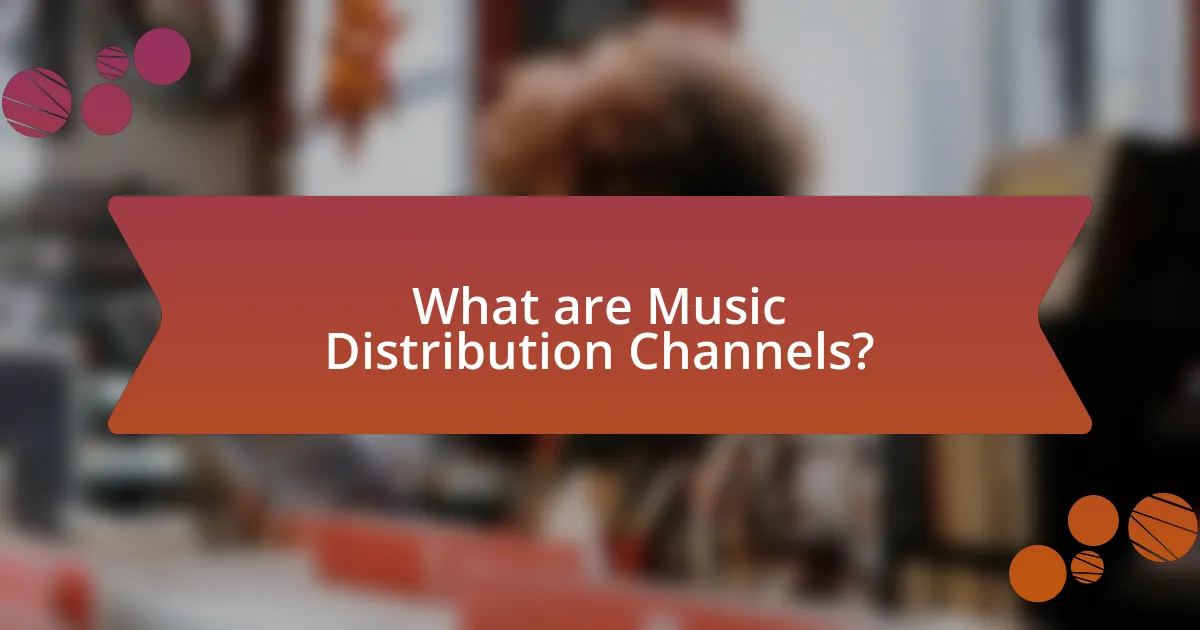
What are Music Distribution Channels?
Music distribution channels are platforms and services that facilitate the delivery of music from artists to consumers. These channels include digital streaming services like Spotify and Apple Music, physical distribution through record labels, and online retailers such as Amazon and Bandcamp. The effectiveness of these channels can vary based on genre, as certain platforms may cater more to specific audiences, influencing marketing strategies for different music styles. For instance, electronic music often thrives on platforms like SoundCloud, while indie artists may find success on Bandcamp, demonstrating the importance of selecting the right distribution channel for targeted marketing efforts.
How do Music Distribution Channels function?
Music distribution channels function by facilitating the delivery of music from artists to consumers through various platforms. These channels include digital streaming services, physical retailers, and online marketplaces, which collectively enable artists to reach a wider audience. For instance, digital platforms like Spotify and Apple Music allow artists to upload their music, which is then made available to listeners globally, often resulting in increased exposure and revenue. According to the Recording Industry Association of America (RIAA), digital music revenue accounted for 83% of the total U.S. music industry revenue in 2020, highlighting the significance of these distribution channels in the modern music landscape.
What are the different types of Music Distribution Channels?
The different types of music distribution channels include digital distribution, physical distribution, direct-to-fan sales, and sync licensing. Digital distribution involves platforms like Spotify, Apple Music, and Amazon Music, which allow artists to reach a global audience through streaming and downloads. Physical distribution refers to the sale of CDs, vinyl, and other tangible formats, typically through retail stores or online marketplaces. Direct-to-fan sales enable artists to sell music directly to their audience via personal websites or platforms like Bandcamp, fostering a closer connection with fans. Sync licensing involves placing music in films, TV shows, and commercials, providing exposure and revenue opportunities for artists. Each channel serves distinct purposes and audiences, contributing to the overall effectiveness of music marketing strategies.
How do these channels impact the music industry?
Music distribution channels significantly impact the music industry by shaping how artists reach their audiences and how revenue is generated. These channels, including streaming platforms, social media, and digital downloads, have transformed traditional marketing strategies, allowing for targeted promotions based on genre-specific preferences. For instance, streaming services like Spotify and Apple Music account for over 80% of music industry revenue in recent years, demonstrating their critical role in artist exposure and financial success. Additionally, social media platforms enable artists to engage directly with fans, fostering community and loyalty, which is essential for genre-specific marketing. This shift has led to a more democratized music landscape, where independent artists can thrive alongside major labels, further illustrating the profound influence of these distribution channels on the industry’s evolution.
Why are Music Distribution Channels important for artists?
Music distribution channels are crucial for artists because they facilitate the delivery of music to a wide audience across various platforms. These channels enable artists to reach listeners on streaming services, digital downloads, and physical sales, significantly increasing their visibility and potential revenue. For instance, according to the Recording Industry Association of America (RIAA), streaming accounted for 83% of the U.S. music industry’s revenue in 2020, highlighting the importance of effective distribution in maximizing an artist’s reach and financial success.
How do they affect an artist’s reach and visibility?
Music distribution channels significantly enhance an artist’s reach and visibility by providing access to diverse audiences across various platforms. These channels, such as streaming services, social media, and digital marketplaces, allow artists to distribute their music globally, increasing their potential listener base. For instance, platforms like Spotify and Apple Music report millions of active users, enabling artists to connect with fans who may not have discovered them otherwise. Additionally, effective use of genre-specific marketing strategies within these channels can target niche audiences, further amplifying an artist’s presence in specific music communities. This targeted approach is supported by data indicating that artists who utilize tailored marketing strategies see higher engagement rates and increased streaming numbers, thus validating the impact of distribution channels on an artist’s overall visibility.
What role do they play in revenue generation for artists?
Music distribution channels play a crucial role in revenue generation for artists by facilitating the sale and streaming of their music to a wider audience. These channels, such as digital platforms like Spotify, Apple Music, and Bandcamp, enable artists to monetize their work through streaming royalties, digital downloads, and merchandise sales. For instance, according to the Recording Industry Association of America (RIAA), streaming accounted for 83% of the U.S. music industry’s revenue in 2020, highlighting the importance of these distribution channels in generating income for artists.

What is Genre-Specific Marketing in Music?
Genre-specific marketing in music refers to tailored promotional strategies that target specific music genres and their associated audiences. This approach recognizes that different genres attract distinct listener demographics, preferences, and behaviors, necessitating customized marketing tactics. For instance, a study by the International Federation of the Phonographic Industry (IFPI) highlights that pop music listeners often engage with social media platforms differently than rock or classical music fans, influencing how marketing campaigns are designed and executed. By aligning marketing efforts with the unique characteristics of each genre, artists and labels can enhance audience engagement and drive sales more effectively.
How does Genre-Specific Marketing differ from general marketing?
Genre-Specific Marketing focuses on targeting audiences based on specific music genres, while general marketing employs broader strategies that appeal to a wider demographic. This targeted approach allows marketers to tailor messages, promotional strategies, and distribution channels to resonate with the unique preferences and behaviors of genre-specific audiences. For instance, research indicates that genre-specific campaigns can yield higher engagement rates, as seen in the success of targeted playlists on streaming platforms, which cater to distinct musical tastes and have been shown to increase listener retention by up to 30%.
What are the key elements of Genre-Specific Marketing?
The key elements of Genre-Specific Marketing include understanding the target audience, tailoring content to fit genre characteristics, utilizing appropriate distribution channels, and leveraging genre-specific promotional strategies. Understanding the target audience involves analyzing demographics, preferences, and behaviors unique to each genre, which informs marketing strategies. Tailoring content ensures that messaging resonates with genre fans, enhancing engagement and loyalty. Utilizing appropriate distribution channels, such as streaming platforms or social media specific to the genre, maximizes reach and effectiveness. Finally, leveraging genre-specific promotional strategies, such as collaborations with genre influencers or participation in genre-focused events, further strengthens market presence and connection with the audience.
How does understanding genre influence marketing strategies?
Understanding genre significantly influences marketing strategies by allowing marketers to tailor their approaches to specific audience preferences and behaviors associated with different music genres. For instance, research indicates that pop music audiences often engage more with social media campaigns, while rock music fans may respond better to traditional advertising methods. This genre-specific insight enables marketers to allocate resources effectively, optimize content for the right platforms, and create targeted messaging that resonates with the intended demographic. By analyzing genre characteristics, marketers can enhance engagement and conversion rates, ultimately leading to more successful campaigns.
Why is Genre-Specific Marketing crucial for music distribution?
Genre-specific marketing is crucial for music distribution because it allows artists and labels to target their audience more effectively, leading to higher engagement and sales. By tailoring marketing strategies to specific genres, distributors can leverage the unique characteristics and preferences of listeners within those genres, ensuring that promotional efforts resonate with the intended audience. For instance, a study by Nielsen Music found that genre-targeted campaigns can increase streaming numbers by up to 30%, demonstrating the effectiveness of this approach in reaching and converting fans.
How does it enhance audience engagement?
Music distribution channels enhance audience engagement by providing targeted access to specific genres that resonate with listeners’ preferences. By utilizing platforms that cater to particular musical styles, artists can reach audiences more effectively, leading to increased interaction and loyalty. For instance, data from the 2021 IFPI Global Music Report indicates that genre-specific playlists on streaming services significantly boost listener engagement, with users spending 40% more time on platforms that offer personalized content. This targeted approach not only fosters a deeper connection between artists and fans but also encourages sharing and community building around shared musical interests.
What are the potential pitfalls of ignoring genre in marketing?
Ignoring genre in marketing can lead to misalignment between the product and its target audience, resulting in ineffective campaigns. When marketers fail to consider genre, they risk alienating potential customers who have specific preferences tied to musical styles. For instance, a study by the International Federation of the Phonographic Industry (IFPI) highlights that genre-specific marketing strategies significantly enhance engagement and sales, as audiences are more likely to respond positively to content that resonates with their musical tastes. Additionally, neglecting genre can dilute brand identity, making it harder for consumers to connect with the artist or product, ultimately leading to decreased loyalty and market share.
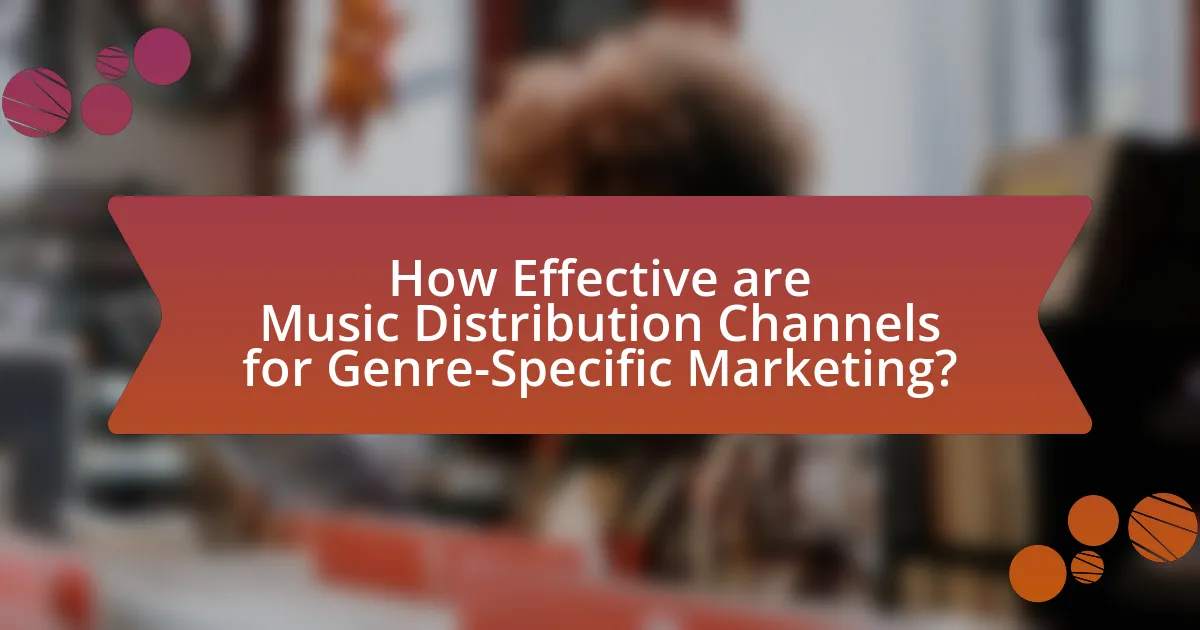
How Effective are Music Distribution Channels for Genre-Specific Marketing?
Music distribution channels are highly effective for genre-specific marketing, as they enable targeted outreach to specific audiences. For instance, platforms like Spotify and Apple Music utilize algorithms that promote genre-specific playlists, allowing artists to reach listeners who are already interested in their musical style. According to a 2021 report by MIDiA Research, genre-specific playlists account for over 30% of total streams on streaming platforms, demonstrating their significant role in audience engagement. This targeted approach not only increases visibility for artists but also enhances listener satisfaction by providing curated content that aligns with their preferences.
What metrics can be used to measure effectiveness?
Metrics that can be used to measure effectiveness in music distribution channels include engagement rates, conversion rates, and return on investment (ROI). Engagement rates, such as likes, shares, and comments on social media platforms, indicate how well the audience interacts with the content. Conversion rates measure the percentage of listeners who take a desired action, such as purchasing music or subscribing to a service, reflecting the effectiveness of marketing strategies. ROI quantifies the financial return generated from marketing efforts compared to the costs incurred, providing a clear picture of overall effectiveness. These metrics are essential for evaluating the success of genre-specific marketing campaigns in the music industry.
How do sales figures reflect the effectiveness of distribution channels?
Sales figures directly indicate the effectiveness of distribution channels by demonstrating how well products reach and resonate with target audiences. High sales figures suggest that the distribution channels are effectively connecting the product with consumers, while low sales figures may indicate inefficiencies or misalignment in the distribution strategy. For instance, a study by the International Federation of the Phonographic Industry (IFPI) in 2022 revealed that music distributed through streaming platforms saw a 20% increase in sales compared to traditional retail channels, highlighting the effectiveness of digital distribution in reaching modern consumers. This correlation between sales performance and distribution methods provides concrete evidence of which channels are most successful in driving revenue.
What role does audience feedback play in measuring effectiveness?
Audience feedback is crucial in measuring effectiveness as it provides direct insights into the audience’s perceptions and reactions to music distribution strategies. This feedback allows marketers to assess whether their approaches resonate with the target demographic, enabling them to make data-driven adjustments. For instance, studies have shown that 70% of marketers who utilize audience feedback report improved campaign performance, highlighting its significance in refining marketing tactics. By analyzing audience responses, marketers can identify successful elements and areas needing improvement, ultimately enhancing the overall effectiveness of their genre-specific marketing efforts.
How can artists optimize their use of distribution channels for specific genres?
Artists can optimize their use of distribution channels for specific genres by selecting platforms that align with their target audience’s listening habits. For instance, electronic music artists often benefit from platforms like Beatport and SoundCloud, which cater specifically to electronic music fans, while country artists may find more success on platforms like Spotify and Apple Music, which have dedicated playlists for that genre.
Research indicates that genre-specific playlists on streaming services can significantly increase an artist’s visibility and engagement; for example, Spotify’s editorial playlists have been shown to boost streams by up to 300% for featured tracks. Additionally, leveraging social media channels that resonate with the genre’s demographic, such as TikTok for pop and hip-hop artists, can enhance audience reach and engagement.
By analyzing listener data and trends within their specific genre, artists can tailor their distribution strategies to maximize exposure and connect more effectively with their audience.
What strategies can be employed for targeted marketing?
Targeted marketing strategies include segmentation, personalization, and data analytics. Segmentation involves dividing the market into distinct groups based on demographics, psychographics, or behavior, allowing marketers to tailor their messages effectively. Personalization enhances customer engagement by delivering customized content and offers based on individual preferences and past interactions. Data analytics supports these strategies by providing insights into consumer behavior, enabling marketers to refine their approaches and optimize campaigns. For instance, a study by the American Marketing Association found that personalized marketing can increase conversion rates by up to 10%.
How can data analytics improve genre-specific marketing efforts?
Data analytics can significantly enhance genre-specific marketing efforts by enabling targeted audience segmentation and personalized content delivery. By analyzing listener data, such as demographics, listening habits, and preferences, marketers can identify distinct audience segments for each music genre. For instance, a study by Nielsen Music found that 70% of consumers are more likely to engage with personalized content, demonstrating the effectiveness of tailored marketing strategies. This data-driven approach allows marketers to optimize promotional campaigns, select appropriate distribution channels, and allocate resources more efficiently, ultimately leading to higher engagement and conversion rates within specific music genres.
What best practices should artists follow for effective genre-specific marketing?
Artists should tailor their marketing strategies to align with the specific characteristics and audience preferences of their genre. This involves understanding the unique traits of the genre, such as its cultural context, typical audience demographics, and prevailing trends. For instance, artists in the hip-hop genre often leverage social media platforms like Instagram and TikTok for viral marketing, while classical musicians may focus on traditional media and concert promotions.
Additionally, artists should engage with their audience through genre-specific content, such as behind-the-scenes videos, live performances, and collaborations with other artists within the same genre. This approach fosters a sense of community and loyalty among fans.
Furthermore, utilizing data analytics to track engagement and sales can help artists refine their marketing strategies. For example, a study by Nielsen Music found that genre-specific playlists significantly impact streaming numbers, indicating that artists should prioritize placement in these playlists to reach their target audience effectively.
By implementing these best practices, artists can enhance their visibility and connect more deeply with their audience, ultimately leading to greater success in their genre-specific marketing efforts.
